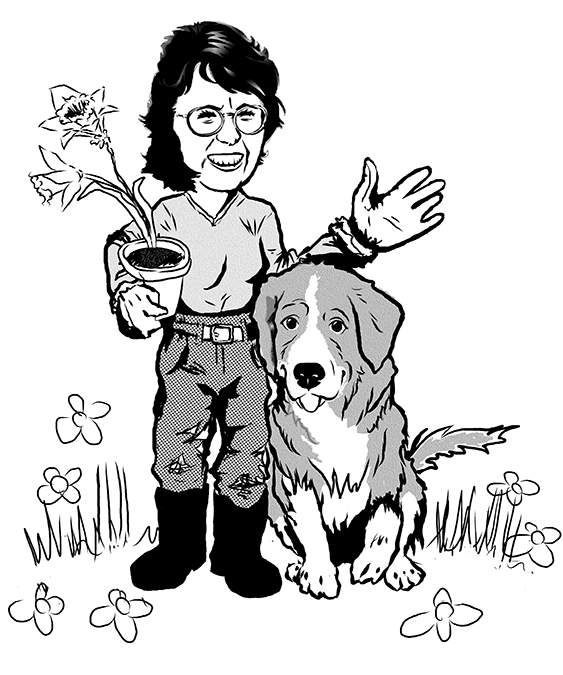Asarum caudatum
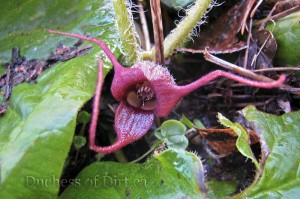 Asarum caudatum Family: Aristolochiaceae
Asarum caudatum Family: Aristolochiaceae
(ah-SAR-um kaw-DAH-tum)
Common name: British Columbia wild ginger; western
wild ginger; long-tailed wild ginger
Zone: 3 – 8
Height: 5-8 in (12-20 cm)
Spread: 12-18 in (60-75 cm)
Aspect: partial shade; full shade
Soil: moderately fertile; well-draining
Water: moderate
Description: A semi-evergreen perennial with a slowly spreading, ground-covering habit. Kidney-shaped, medium green, glossy leaves show their distinctive veining. Leaf stems are covered in very fine, soft hairs. Cup-shaped, brownish-purple flowers appear in mid-spring. Very distinctive with their petals terminating in long, graceful tails. Look for them laying atop the soil, hidden under the leaves.
Special Notes: Native to the Pacific Northwest. Great ground-cover plant but is slow to establish. Will tolerate some sun. Foliage and roots have a spicy ginger and citrus fragrance when crushed. Relatively pest- and disease-free. Slugs and snails may be a problem in early spring. Deer and rabbit resistant. Propagate by fresh seed; divide in early spring or autumn. Will self-sow.
Great Plant Pick 2006
Posted on April 19, 2013; updated on August 7, 2024
Asarum europeaum
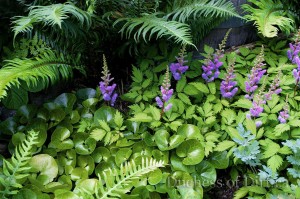 Asarum europaeum
Asarum europaeum
(ah-SAR-um yur-oh-PAY-um)
Family: Aristolochiaceae
Common name: European wild ginger; hazelwort; wild
spikenard; asarabacca
Zone: 3 – 8
Height: 3-6 in (7-15 cm)
Spread: 12-18 in (30-45 cm)
Aspect: partial shade; full shade
Soil: moderately fertile; well-draining
Water: moderate
Description: An evergreen perennial with a slowly spreading, ground-covering habit. Rounded, kidney-shaped, bright green, glossy leaves show their distinctive veining. Leaf stems are covered in very fine, soft hairs. Bell-shaped, brownish-dull purple flowers appear in mid-spring. Look for them laying atop the soil, hidden under the leaves.
Special Notes: Native to Europe. This is a wonderful ground-cover plant but is slow to establish. Be patient. Roots are sometimes harvested for use as a spice or flavouring. Long ago the crushed leaves were used in snuff. Relatively pest- and disease-free. Rust and leaf gall may be a problem in some climates. Deer and rabbit resistant. Propagate by fresh seed; divide in early spring or autumn. Will self-sow.
RHS Award of Garden Merit 2007; Great Plant Pick 2011
Posted on April 18, 2013; updated on August 7, 2024
Artemisia lactiflora Guizhou Group
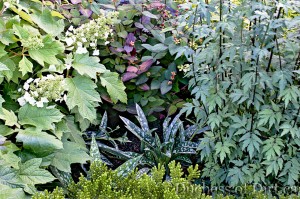 Artemisia lactiflora Guizhou Group
Artemisia lactiflora Guizhou Group
(ar-tay-MIS-ee-ah lak-tih-FLO-rah)
syn. Artemisia lactiflora ‘Guizhou’
Family: Asteraceae
Common name: white mugwort; purple ghost mugwort
Zone: 5 – 8
Height: 4-5 ft (1.2-1.5 m)
Spread: 2 ft (0.6 m)
Aspect: partial shade
Soil: fertile; moist; well-draining
Water: moderate
Description: An herbaceous perennial with a bushy, upright, clump-forming habit. Black-green leaves are quite fern-like with their deeply incised lobes. Sprays of creamy-white flowers appear atop deep maroon-purple stems in late summer through autumn.
Special Notes: This is an improved form of Artemisia lactiflora which was discovered on a 1985 Sino-British expedition to Guizhou Province in China. Introduced as Artemisia #GUIZ137. Good cut flower. Relatively pest- and disease-free. Powdery mildew may be a problem in some climates. Deer and rabbit resistant. Propagate by division in early spring or autumn.
In our Zone 7a garden: This is a stellar performer and a delightfully worry-free plant for us. It also is where we can often find lots of baby slugs hiding out in the spring. The slugs do not eat the leaves…much preferring the ferny, distinctively-coloured foliage for its great camouflage coverage. You have to look hard to find their small, slimy, soft beige bodies hiding within the plant’s clump-forming habit. So a word to the wise, DO NOT place any plants that slugs love to feed on…such as hostas, lettuces and ligularias…in the near vicinity of your Artemisia lactiflora ‘Guizhou’.
Great Plant Pick 2011
Posted on April 18, 2013; updated on August 7, 2024
Arrhenatherum elatius var. bulbosum ‘Variegatum’
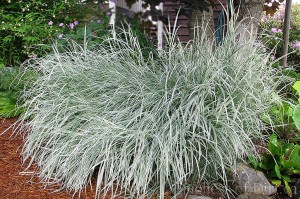 Arrhenatherum elatius var. bulbosum ‘Variegatum’
Arrhenatherum elatius var. bulbosum ‘Variegatum’
(ah-ren-AH-the-rum ay-LAH-tee-us var. bul-BOW-sum)
Family: Poaceae
Common name: variegated bulbous oat grass; variegated false oat grass
Zone: 4 – 8
Height: 12-15 in (30-35 cm)
Spread: 18-24 in (45-60 cm)
Aspect: full sun; partial shade
Soil: average; well-draining
Water: moderate
Description: An herbaceous perennial grass with a tuft-forming habit. Hairless, slender, grey-green leaves are edged in creamy white. Pale green spikelets appear in summer, changing to straw brown colour in autumn.
Special Notes: Native to Europe. This grass increases in size with the formation of chains of yellow bulb-like swellings developing at the base of the stems. Growth is relatively slow and easy to control, however. Remove old foliage in late winter before new leaves emerge. Generally, pest- and disease-free. Deer and rabbit resistant. Propagate by division in early spring or autumn.
Posted on April 18, 2013; updated on August 7, 2024
Aronia melanocarpa
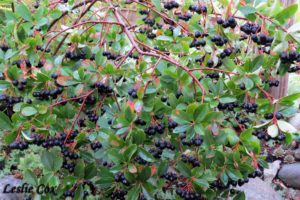 Aronia melanocarpa Family: Rosaceae
Aronia melanocarpa Family: Rosaceae
(ah-ROE-nee-ah mel-an-oh-KAR-pah)
Common name: black chokeberries
Zone: 3 – 8
Height: 3-6 ft (0.9-1.8 m)
Spread: 6-10 ft (1.8-3 m)
Aspect: full sun; partial shade
Soil: average; well-draining
Water: moderate
Description: A medium-sized, deciduous shrub with a fairly low, spreading growth habit. The dark green, glossy leaves are obovate in shape with a rounded tip. Colour turns a wonderful purplish-red in autumn. Clusters of 5-petaled white flowers open for a short bloom period in May, followed by dark, round, edible berries in autumn. Berries first appear dark purple, maturing to black when fully ripe.
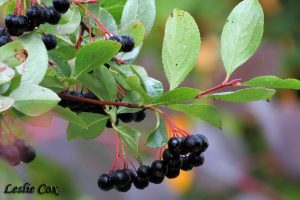 Special Notes: Native to North America, primarily the area around the Great Lakes in Canada and the United States. Once used by the native peoples as a meat preservative in preparing pemmican. More recently, it has been discovered aronia berries have wonderful health benefits. Besides being saturated with natural anti-fungal, anti-bacterial, and anti-diabetic qualities, the berries are rich in anthocyanins and polyphenols…which protect the urinary tract, stimulate the circulation and strengthen the heart. Ongoing studies are showing black chokeberries also contain compounds helpful in fighting certain cancers and heart disease. There is also ongoing research on its benefits for memory loss and cognitive deterioration.
Special Notes: Native to North America, primarily the area around the Great Lakes in Canada and the United States. Once used by the native peoples as a meat preservative in preparing pemmican. More recently, it has been discovered aronia berries have wonderful health benefits. Besides being saturated with natural anti-fungal, anti-bacterial, and anti-diabetic qualities, the berries are rich in anthocyanins and polyphenols…which protect the urinary tract, stimulate the circulation and strengthen the heart. Ongoing studies are showing black chokeberries also contain compounds helpful in fighting certain cancers and heart disease. There is also ongoing research on its benefits for memory loss and cognitive deterioration.
Aronia melanocarpa has few insect or disease problems, although there is some susceptibility to leaf spots…merely a cosmetic problem. Twig and/or fruit blight could also be a slight problem.
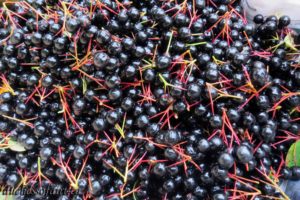 In our Zone 7a garden: Our Aronia shrub sits at the corner of the raised bed by the steps leading up to the pond…and beyond. It was relocated to this location in 2013 after being deemed unsuitable in the first spot John placed it when the plant was purchased in 2011. I only mention this so you have some understanding its current size of about 3 feet (0.9 m) tall and roughly 5 feet (1.5 m) wide may not be its final stature. However, this shrub does lend itself to being kept in check through some judicious pruning.
In our Zone 7a garden: Our Aronia shrub sits at the corner of the raised bed by the steps leading up to the pond…and beyond. It was relocated to this location in 2013 after being deemed unsuitable in the first spot John placed it when the plant was purchased in 2011. I only mention this so you have some understanding its current size of about 3 feet (0.9 m) tall and roughly 5 feet (1.5 m) wide may not be its final stature. However, this shrub does lend itself to being kept in check through some judicious pruning.
This past fall (2016), I managed to beat the birds to the berries. (Warning: you must be quick! As soon as the birds…mainly robins in our garden…pronounce the berries are finally ripe enough to eat, the entire shrub is harvested in two days…three at the very outside.) I froze all of this year’s harvest in batches on a waxpaper-lined cookie sheet and transferred the frozen berries into freezer bags for later use in smoothies. Delicious.
Posted on December 17, 2016; updated on August 6, 2024
